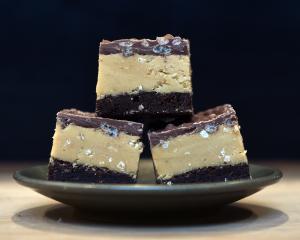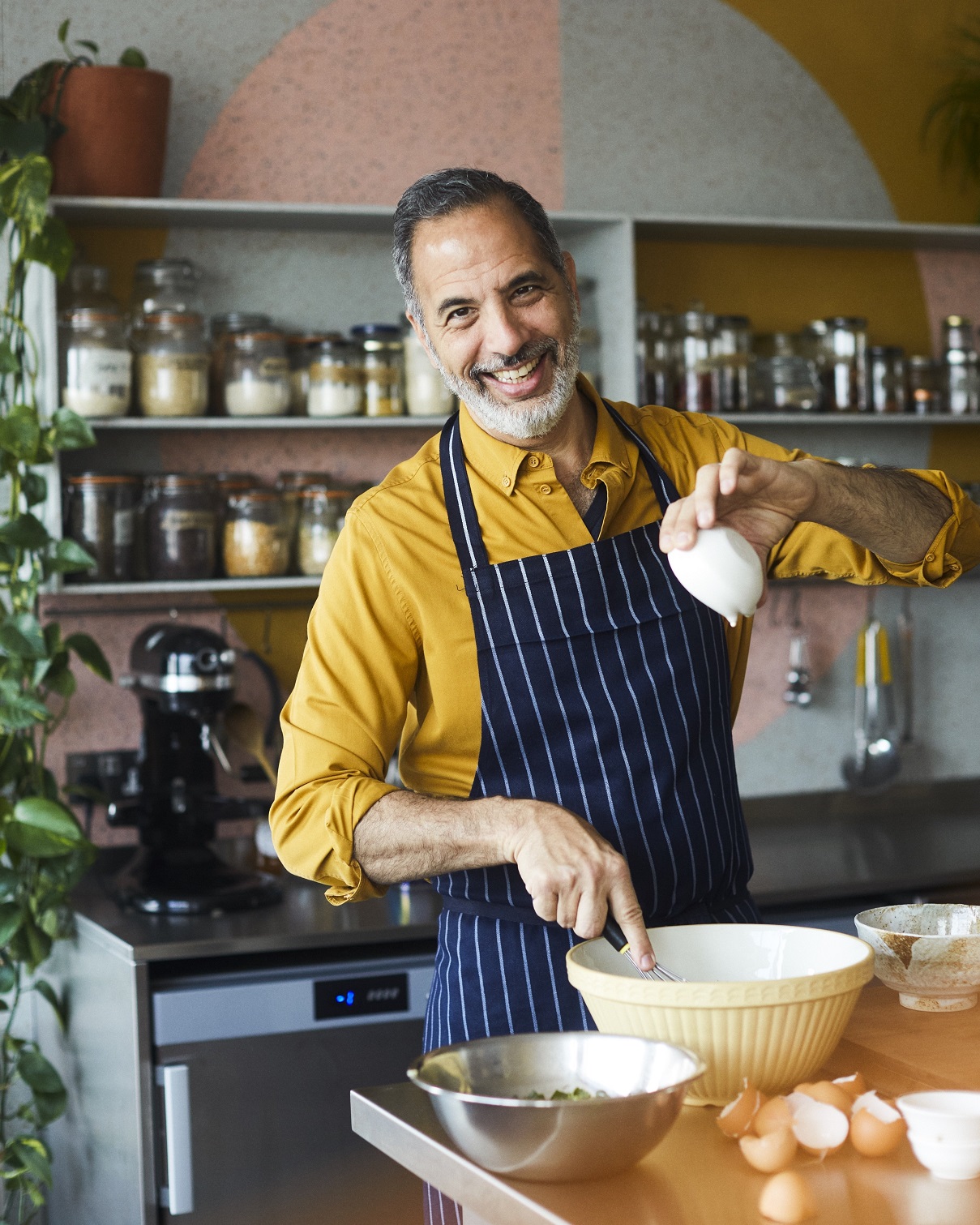
"One person’s idea of comfort food might be the next person’s idea of challenging. It’s so personal, so tied up with home, with family, with memory, even with the random idiosyncrasies of human taste."
It is also culturally specific — mac’n cheese, chicken ramen, schnitzel, sausages and mash, pizza, chicken noodle soup, lentils and rice, dal, dumplings — comfort food for many but there is no one-stop shop.
"Trying to pin down a specific set of comfort food recipes is as slippery as a bowl of noodles," he said.
In his latest book, Ottelenghi and his team, Helen Goh, Verena Lochmuller and Tara Wigley, offer dishes that are both comfortable and creative, familiar and fresh, reassuring and revelatory.
"It is also about the personal journeys we have been on, and all the stories these journeys contain."
Ottolenghi’s journey covers Italy, Germany, Jerusalem, Amsterdam and London, while Goh’s stretches from China to Malaysia and Melbourne to West London. Lochmuller’s includes Germany, Scotland, New York and London and Wigley’s a London girl through and through.

When people move to somewhere new they take on the food and culture of that place yet also keep a hold and preserve the culture and cuisine they have left behind.
"They’re edible transitional objects, and nothing will fast-track us back to that hug years down the line more than making that soup, or those lentils, or that pasta bake."
For the authors of Comfort, the book is a celebration of movement, of immigration, of family, of home and of people.
"Very often it’s about the combination of right food and right time and right place. What makes food comforting can be about where and how we eat, why we eat and who we eat with as much as what we’re eating in the first place."
The Book
Images and text from Comfort by Ottolenghi. RRP $70
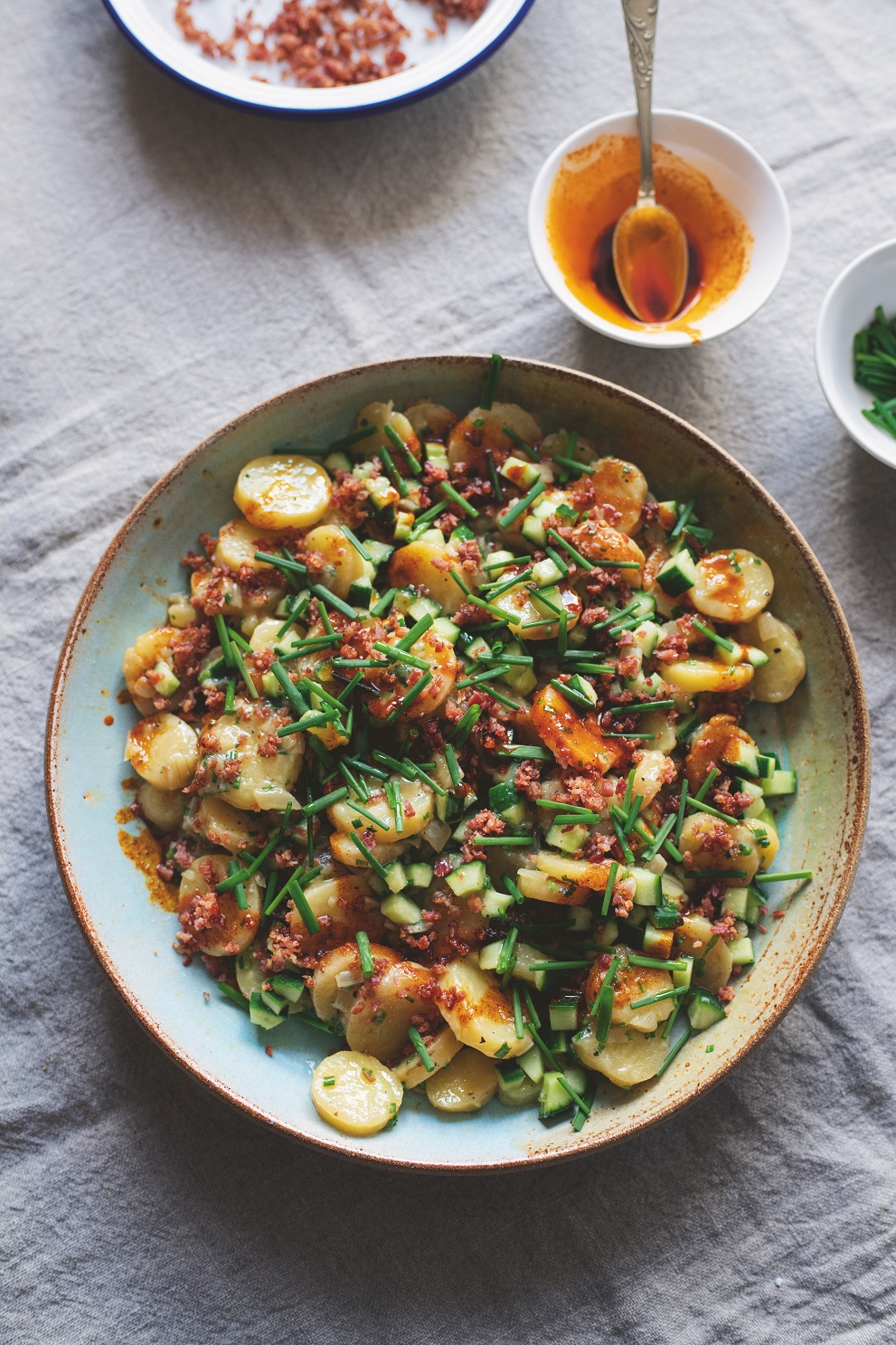 Verena’s potato salad
Verena’s potato salad

Growing up in Germany, Verena remembers two camps when it came to potato salad: camp mayo and camp oil/broth. This is an oil/broth-based version, more prevalent in the southern parts of Germany, specifically Swabia and Bavaria. It’s less heavy and claggy than the mayo variety and gets its creaminess from the starch released by the potatoes as they sit for a couple of hours in the warm broth. We’ve strayed from tradition and added some pancetta (because, why not ... ) and a welcome freshness from some chopped cucumber.
Serves 4
Ingredients
500g Pink Fir or Charlotte (or other waxy) potatoes
75ml olive oil
1 small onion, finely chopped (125g)
1 garlic clove, crushed
175ml chicken stock
2 tsp Dijon mustard
2 tbsp apple cider vinegar
½ tsp black peppercorns, coarsely crushed in a pestle and mortar
15g chives: 10g finely chopped and
5g cut into 1½cm lengths
75g pack of diced smoked pancetta
1 tsp paprika
¼ cucumber, sliced lengthways, deseeded and cut into ½cm dice (100g)
Salt
Method
Put the potatoes into a medium saucepan, for which you have a lid. Add just enough water to cover, salt generously and place on a medium-high heat. Bring to the boil, then reduce the heat to medium-low and cook, covered, for 20-25 minutes, until just tender.
Drain and once cool enough to handle, remove the skins from the potatoes and slice into ½cm-thick rounds. Set aside in a medium bowl.
Put 2 tablespoons of the oil into a medium saute pan and place on a medium heat. Add the onion and cook for 12-15 minutes, stirring regularly, until caramelised. Add the garlic and stock, bring to a simmer, then remove from the heat.
Add the mustard, vinegar, 1¼ teaspoons of salt, the pepper and another 2 tablespoons of oil. Whisk to combine, then pour the mixture over the potatoes. Mix gently but thoroughly: it will look wet (and some of the potatoes will break up), but this is normal. Set aside for about 2 hours, for the potatoes to soak up about half the broth, and then stir in the finely chopped chives.
Meanwhile, wipe clean the saute pan and place on a medium-high heat. Add the pancetta, reduce the heat to medium-low and cook for 10-12 minutes, stirring occasionally, until the pancetta is crispy.
Using a slotted spoon, transfer to a plate lined with kitchen paper leave about 1 tablespoon of the fat in the pan and set aside. Once cool, finely chop the pancetta into crumbs.
Add the remaining tablespoon of oil to the fat in the pan, along with the paprika. Stir for 30 seconds or so, until fragrant, then remove from the heat.
When ready to serve, fold the cucumber into the potato salad and transfer to a serving plate. Scatter over the pancetta crumbs, along with the cut chives. Spoon over the paprika oil and serve.
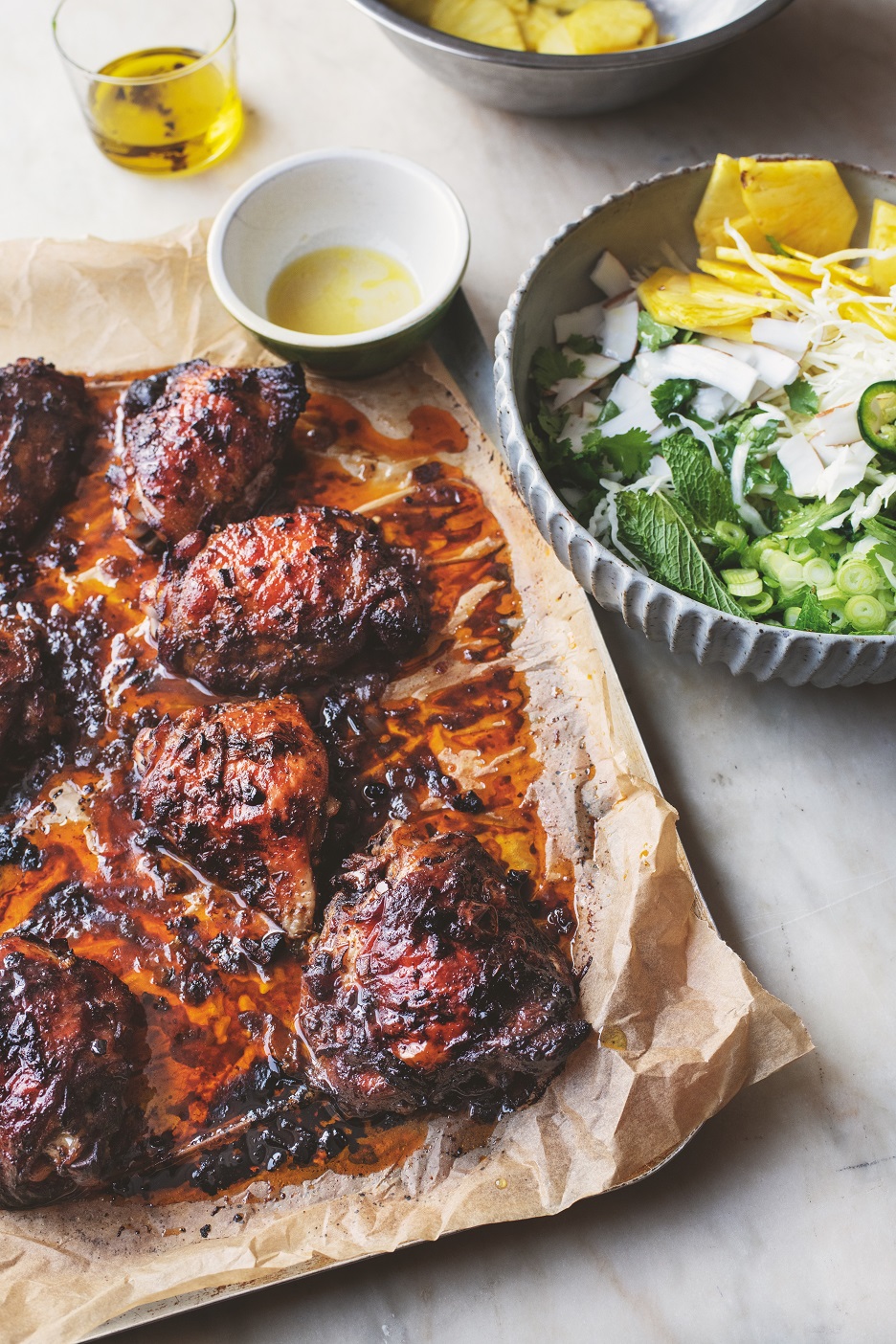 Chicken with Steph’s spice
Chicken with Steph’s spice

Steph was a Jamaican chef Helen worked with many years ago in Melbourne. A lot of time has passed since the recipe for Steph’s roasted jerk-spiced meats was handed on — passed around the kitchen, scribbled down on a scrap of paper — but it’s been with Helen ever since. Recipes, like postcards, flying around the world with the scent of a place on one side, scribbled greetings on the other. We served the chicken with a simple slaw made with half a small cabbage and a quarter of a pineapple, both thinly sliced, some freshly flaked coconut, sliced jalapeno, spring onion, coriander and mint. It’s dressed with olive oil, lime juice and maple syrup.
Serves 4
Ingredients
1 tsp whole allspice berries (aka pimento)
2 bay leaves, roughly torn
1½ tsp hot chilli powder
1½ tsp paprika
½ tsp ground cinnamon
½ tsp mixed spice (the sweet one, like pumpkin spice)
25g light soft brown sugar
1½ Tbsp runny honey
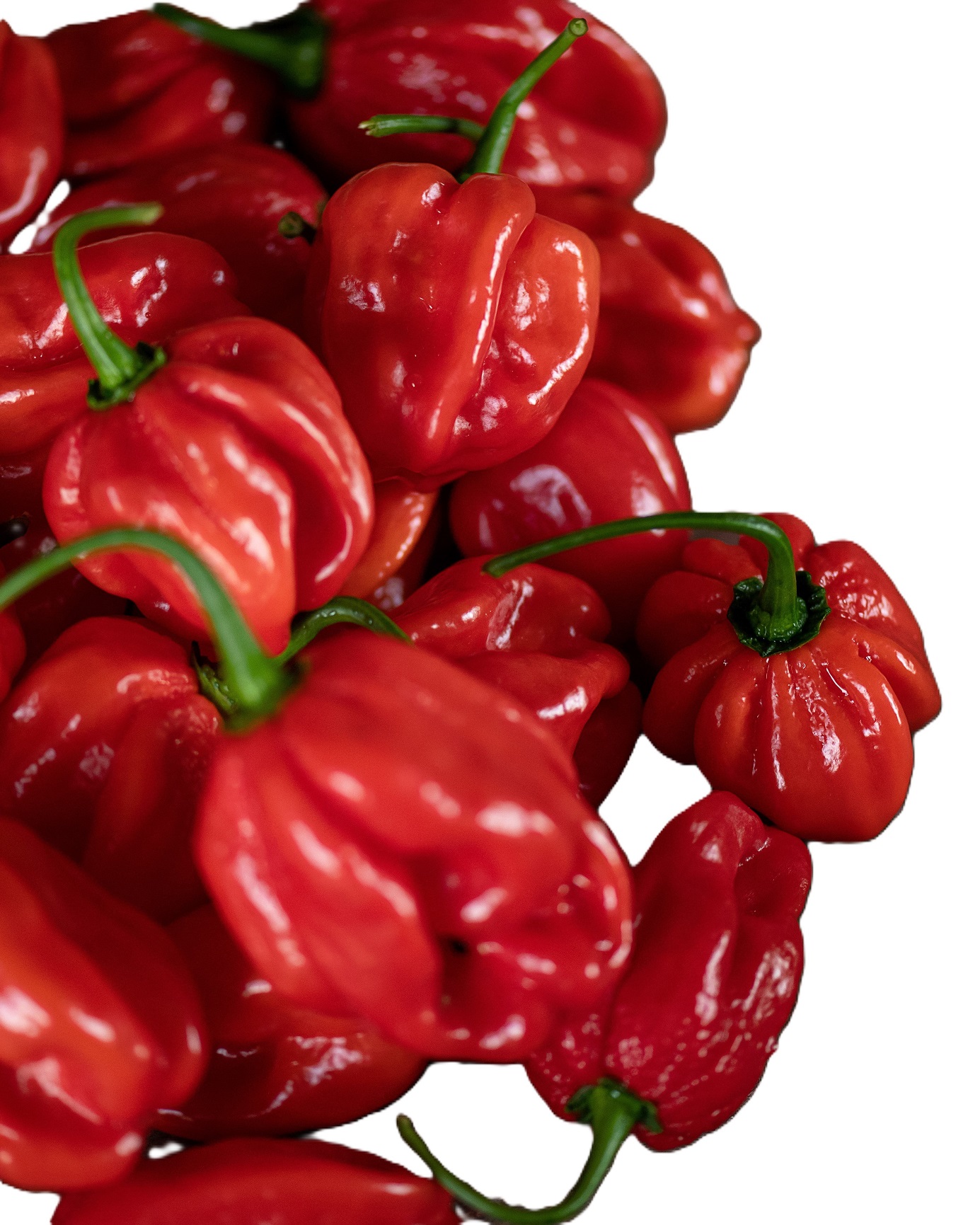
12 red Scotch bonnet (habanero) chillies, finely chopped
1 small red onion, cut into 1cm dice (100g)
2 spring onions, finely chopped (30g)
50ml olive oil
1kg chicken thighs, bone in, skin on
2 Tbsp white wine vinegar
Salt
Method
Put the allspice and bay leaves into a dry pan and toast them for 12 minutes, until the bay leaves have blistered. Using a pestle and mortar, crush to a powder, then tip into a large bowl along with all the remaining ingredients apart from the chicken and vinegar. Add 1 teaspoon of salt, mix well to combine, then add the chicken. Massage well, so that all the thighs are coated, then keep in the fridge, covered, for at least 6 hours (or overnight).
Half an hour before you are going to cook the chicken, take it out of the fridge, add the vinegar and toss to combine.
Preheat the oven to 180°C fan. Spread the chicken out on a large parchment-lined baking tray, skin side up. Bake for about 45 minutes, rotating the tray halfway through, until crisp and golden brown.
Remove from the oven and allow to rest for 10 minutes before serving.
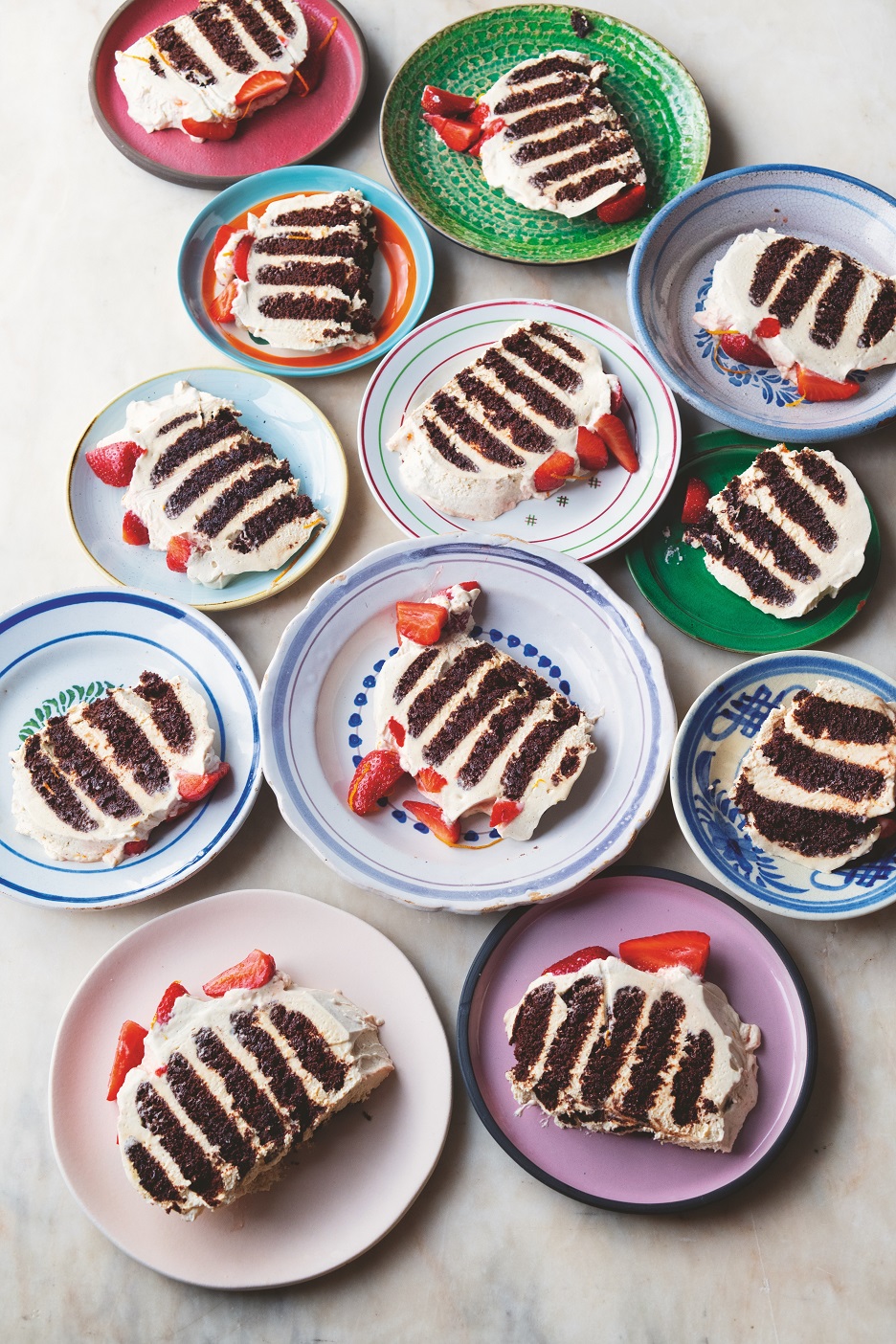 Chocolate ripple fridge cake
Chocolate ripple fridge cake

As anyone who's ever been to an Australian barbecue will know, chocolate ripple cake is a ubiquitous, no-bake dessert. In Australia, it’s made with shop-bought chocolate biscuits which are then sandwiched together with cream. The recipe is so simple that it’s printed on the back of the biscuit packet! On a recent family trip back to Melbourne, Helen’s children were so taken by the cake that they begged her to make it back in London. Not being able to get hold of the right biscuits Arnotts Choc Ripple (though they are now available online) Helen made them from scratch. They’re so quick and simple to bake that Helen now not only bakes them to make the cake but, also, makes extra biscuits to have around. No birthday party (or barbecue!) is complete without them.
Serves 8-10
Ingredients
3 Tbsp milk (or 105ml if not using the Grand Marnier)
60ml Grand Marnier (if using)
1 espresso shot, regular or decaf (30ml)
650ml double cream
325g creme fraiche
50g icing sugar
1½ tsp vanilla extract
1½ tsp ground cinnamon
Biscuits
225g plain flour
50g cocoa powder
¾ tsp baking powder
1½ tsp bicarbonate of soda
½ tsp salt
100g unsalted butter, at room temperature
200g caster sugar
50ml vegetable oil
50g golden syrup
1 egg
Macerated strawberries
600g strawberries, hulled and quartered
1½ Tbsp caster sugar
1 tsp finely shaved orange zest
2 tbsp Grand Marnier (or orange juice)
2 strips of orange zest, julienned
Method
First make the biscuits. Sift the flour, cocoa powder, baking powder, bicarbonate of soda and salt into a medium bowl.
Place the butter, sugar, oil and golden syrup in the bowl of a stand mixer with the paddle attachment in place. Beat on a medium speed for 2 minutes, until light and creamy. Scrape the sides of the bowl, then add the egg and beat again until combined. Reduce the speed to low, add the dry ingredients and mix until the dough comes together. Wrap and chill in the fridge for at least 2 hours.
When ready to bake, preheat the oven to 170°C fan.
Pinch off 30g pieces of dough and roll them into balls, then place them, spaced about 5cm apart, on two large parchment-lined baking trays. You should make about 23 balls. Flatten them with your hand until they are about 5cm wide then bake for 15 minutes, until firm and the tops are cracked or rippled. Remove from the oven and allow to cool for 5 minutes before transferring to a wire rack to cool completely.
When ready to assemble the cake, combine the milk, Grand Marnier (if using) and espresso and set aside.
Place the cream, creme fraiche, icing sugar, vanilla extract and cinnamon in the bowl of the stand mixer with the whisk attachment in place. Whisk on a medium-high speed until soft peaks form: be careful not to over-whip, as the cream will thicken as you spread it.
Transfer 200g of the mixture to a small bowl and refrigerate: this will be used to finish the cake. Pipe or dollop a roughly 30cm-long line (about 2cm wide) of the remaining cream mixture down the centre of a long cake plate or board: this is to help position the biscuits for assembly.
Take 20 of the biscuits and, working with one biscuit at a time, lightly brush both sides with the milk mixture: you want to just moisten the entire biscuit without drenching it.
Then, using a small spatula or knife, spread 2Tbsp of the cream on one side of the biscuit. Standing the biscuit upright, press it down on to one end of the strip of cream. Repeat with another biscuit, then place alongside the first biscuit, pressing to sandwich them together. Continue with the remaining biscuits to form a long log cake.
Spread the remaining cream mixture over the top and sides of the log: don’t worry if it only barely covers the cake, as it will be topped up with the reserved cream the following day. Cover loosely and refrigerate for at least 6 hours or overnight.
About 15 minutes before you’re ready to serve, combine the strawberries in a bowl with the sugar, finely shaved orange zest and Grand Marnier. Leave to macerate for 10-15 minutes.
Meanwhile, spread the reserved cream over the top and sides of the log.
When ready to serve, tumble about half the strawberries along the top of the cake, pressing them on slightly to help them stick. Drizzle any syrup over and around the plate. Finish with the orange zest strips on top. When serving, slice on the diagonal warming the blade of the knife in a jug of hot water helps with the cleanness of the slice to reveal the stripes.
Playing around:
The strawberries work really well here but, as an alternative, just crumble over another cookie or a chocolate flake.
Getting ahead:
The biscuits can be made and baked up to 7 days in advance and kept in an airtight container. The cake needs to be made up to 6 hours before serving, to allow it to soften and meld together, but can be made up to 2 days in advance, left to sit and wait in the fridge.






